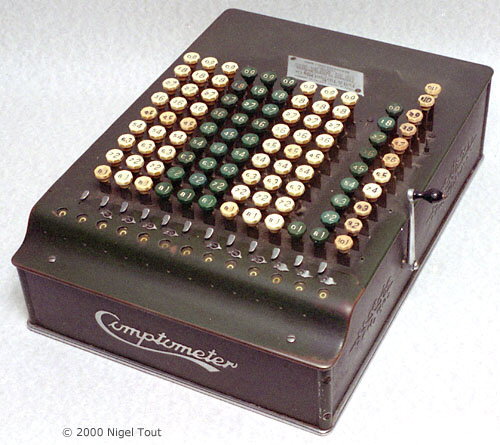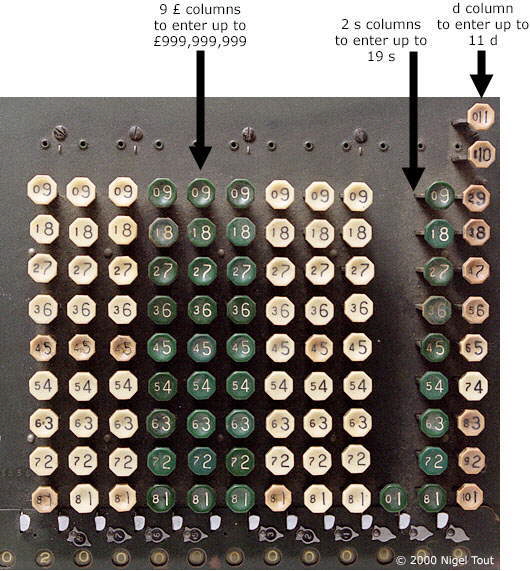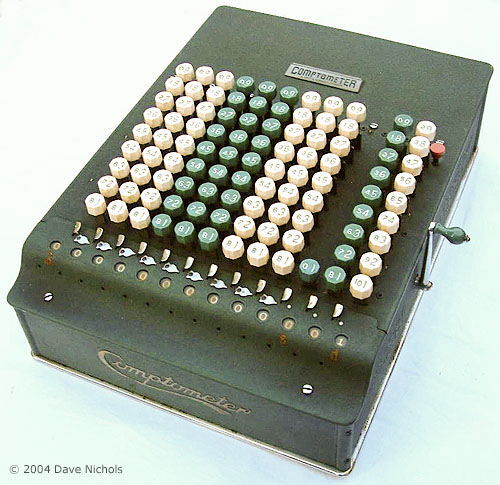Sterling Currency Calculators
Full-Keyboard Comptometer

Model J Sterling currency Comptometer.

The Sterling currency keyboard.
The machine can be used in decimal mode by ignoring the three rightmost columns of keys.
The full-keyboard Sterling Comptometer illustrated was made by the Felt & Tarrant Manufacturing Co. in the USA in the 1920s or 30s. It is a model J, serial number J331518.
310 mm wide, 375 mm deep, 150 mm high (12.5" x 15" x 6"), 11.5 Kg (25.5 lbs).
Standard decimal Comptometers have all columns identical with 9 keys in each (no key is required for 0).
This example is a Sterling version. It has non-standard numbers of keys in some columns (see photograph below), from left to right :-
- 9 Pound columns each with nine keys (1-9),
- a column for tens of Shillings with a single key (1),
- a column with nine keys
- a column for Pence with 11 keys (1-11)
The maximum value that can be calculated is 9,999,999,999 Pounds, 19 Shillings, and 11 Pence (ie. £9,999,999,999/19s/11d).
The 2 extra keys required in the Pence column would have caused problems for manufacture on a standard production line.
Note that there are 2 numbers marked on each key -
- The larger one is used for addition.
- The smaller one is used for subtraction using the "9's complement" method (or in the case of the d column "12's complement").

The machine pictured on the left is also a model J, serial number 297617.
It is unusual because:
- It only has 10 keys in the pence column (to enter 10 or 11 you have to press one key then another which add up to the required value.
- It has later model style, thick keys.
- It has a later model style "Comptometer" badge at the rear of the keys, rather than the usual "Felt and Tarrant" badge.
Note that these Sterling currency machines can be used for normal decimal calculations by ignoring the rightmost three columns.
There are instructions for the basic use of Comptometer-type machines in the article "Operating a Comptometer" on this site.
An excellent source of information on Felt & Tarrant Comptometers is at http://www2.cruzio.com/~vagabond/ComptHome.html
The Comptometer was the first succesfull key driven
adding and calculating machine.
"Key driven" means that just pressing the keys adds the numbers entered to the total - no other action is required - so it is very quick for adding long lists of numbers.
It was invented by the American Dorr E. Felt in 1884, and produced by the Felt & Tarrant Manufacturing Company.
The Comptometer's basic function is addition. There is a column of keys (in general 1-9) for each decade. When a key is pressed, that number is added to that decade, with carry to the next higher decade, if
applicable. Pulling the handle forwards clears the total to zero.
Subtraction, multiplication, and division are also possible on Comptometers using special techniques.
"Comptometer" eventually became to be used as a generic name for calculators of this type from all manufacturers.
Standard decimal Comptometers have all columns identical with 9 keys in each (no key is required for 0).
Comptometers were very fast in operation when adding up lists, such as required in accounting. Operators were specially trained to enter each complete number by pressing multiple keys in different columns in one go using
separate fingers. In other words the digits were entered in parallel, the mechanism being able to cope with this.
In contrast a modern electronic calculator only has 10 digit keys so the digits of each number have to be
entered one at a time, serially, which is slower.
Comptometers were used into the late 1970s and were ousted by advances in the use of computers for accounting rather than the development of electronic calculators.
Click here for more information about Comptometers.
Sterling Calculators
Vintage Calculators
Text & photographs copyright, except where stated otherwise, © Nigel Tout 2000-2026.